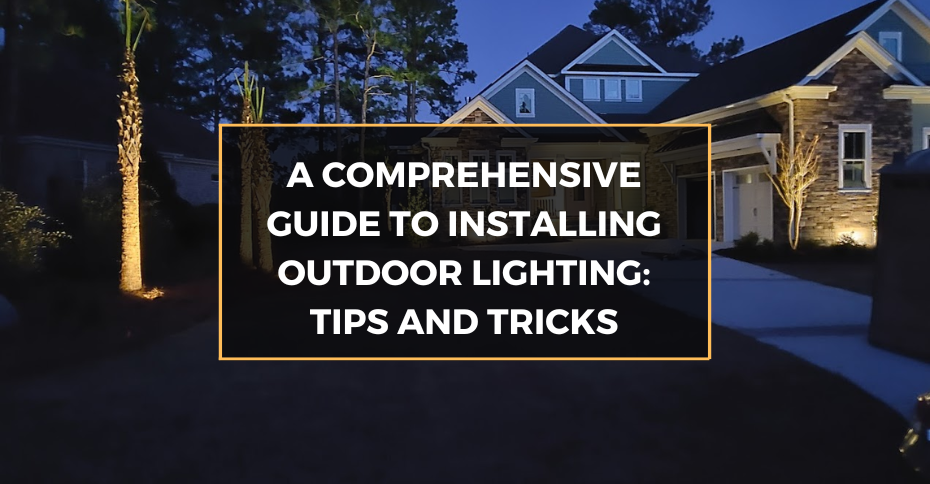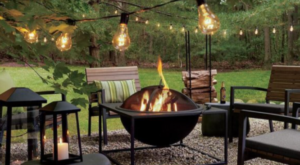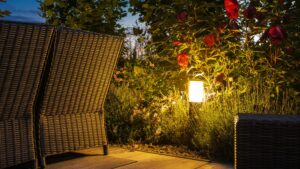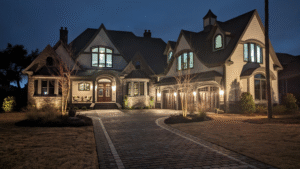Planning Your Outdoor Lighting
Effective planning is the cornerstone of a successful outdoor lighting project. It involves a thorough assessment of your outdoor space and strategic design to ensure that every area is appropriately illuminated.
Assessing Your Outdoor Space
Assessing your outdoor space is the first crucial step in installing outdoor lighting. Begin by identifying the key areas that require illumination, such as pathways, garden beds, patios, and entryways. Consider the purpose of each light—whether it’s for safety, aesthetics, or functionality. Take note of existing features like trees, shrubs, and architectural elements that can be highlighted or may obstruct lighting.
It’s also essential to measure the space to determine how many fixtures you’ll need and their optimal placement. Walk around your yard at night to understand the natural light levels and where additional lighting would be beneficial. Assessing the outdoor space thoroughly ensures that you can create a balanced and effective lighting plan.
Designing Your Lighting Layout
Designing your lighting layout involves creating a detailed plan that outlines where each light fixture will be placed. Start by sketching a rough map of your yard, marking the locations of key elements and where you’d like to install lights. Consider the direction and spread of light to avoid dark spots and ensure even illumination.
Think about how the lighting will look from different angles, both from inside your home and from the street. Incorporate a variety of lighting types, such as ambient, task, and accent lighting, to create layers and depth. Planning your layout helps you visualize the final result and ensures a cohesive and functional lighting design.
Selecting the Right Fixtures When Installing Outdoor Lighting
Selecting the right fixtures is crucial to achieving the desired look and performance for your outdoor lighting.
Understanding Different Fixture Types
Understanding different fixture types is essential when installing outdoor lighting. Pathway lights are small that line walkways and driveways, providing safety and guiding visitors. Floodlights are powerful and can illuminate large areas, making them ideal for security purposes. Spotlights focus on specific features, such as trees or statues, creating dramatic effects.
Wall lights are mounted on vertical surfaces, offering both illumination and decoration for entryways and patios. Deck lights are installed in decking to highlight steps and edges, enhancing safety and ambiance. Each fixture type serves a unique purpose, so knowing their functions helps in making informed decisions for your outdoor lighting project.
Choosing the Right Bulbs
Choosing the right bulbs is crucial for effective outdoor lighting. LED bulbs are the most popular choice due to their energy efficiency and long lifespan. They produce bright light with minimal heat, making them safe for outdoor use. Halogen bulbs offer bright, white light but consume more energy and have a shorter lifespan compared to LEDs.
Incandescent bulbs, while less efficient, provide a warm glow suitable for creating a cozy atmosphere. When selecting bulbs, consider factors like brightness, color temperature, and energy consumption to ensure optimal performance for your outdoor lighting.
Step-by-Step Installation Instructions
Installing outdoor lighting requires meticulous attention to detail and a systematic approach to ensure optimal performance and safety.
Gathering Necessary Tools and Materials
Before starting the installation of outdoor lighting, gather all necessary tools and materials to streamline the process. You’ll need a shovel or trowel for digging, a drill for mounting fixtures, wire strippers, electrical tape, and connectors for wiring, and a voltage tester to ensure safety.
Make sure to have all your light fixtures, bulbs, and any additional components like transformers or timers. Having everything on hand prevents delays and ensures a smoother installation process. Additionally, read through the manufacturer’s instructions for each component to familiarize yourself with the specific requirements and recommendations.
Preparing the Site for Installing Outdoor Lighting
Preparing the installation site is a crucial step in installing outdoor lighting. Start by marking the locations where each fixture will be installed according to your lighting layout plan. Clear any debris, rocks, or obstructions from these areas to create a clean working environment.
For pathway lights, dig shallow trenches for the wiring and ensure the ground is level for even placement of fixtures. For wall-mounted lights, ensure the surface is clean and free of any loose material. Properly preparing the site helps to avoid complications when installing outdoor lighting and ensures a stable and secure setup for your outdoor lighting fixtures.
Tips and Tricks for a Successful Installation
Achieving a successful outdoor lighting installation involves more than just following instructions. It requires practical insights and expert tips to avoid common pitfalls and ensure a smooth process.
Avoiding Common Mistakes When Installing Outdoor Lighting
Avoiding common mistakes can save time and effort when installing outdoor lighting. One common error is overloading the circuit, which can cause lights to flicker or trip the breaker. Ensure you calculate the total wattage of your lighting system and match it with the capacity of your circuit. Another mistake is improper spacing of fixtures, leading to uneven illumination or dark spots.
Follow your layout plan carefully to maintain consistent lighting. Failing to use waterproof connectors can result in short circuits or malfunctioning lights. Always use weatherproof materials and double-check all connections to prevent these issues. Avoiding these common mistakes ensures a smooth and effective lighting installation.
Ensuring Proper Wiring and Connections
Ensuring proper wiring and connections is essential for the safety and longevity of your outdoor lighting system. Use high-quality, weather-resistant wires and connectors designed for outdoor use. Make sure all connections are secure and insulated to prevent water ingress and corrosion.
Regularly inspect the wiring for signs of wear or damage and replace any compromised components promptly. Label the wires during installation to easily identify connections if troubleshooting is needed. Proper wiring practices not only ensure your lights work efficiently but also minimize the risk of electrical hazards. Investing time in proper wiring techniques can save you from future maintenance and repairs.
Testing Your Lighting Setup
Testing your lighting setup is a crucial final step in the installation process. Once all fixtures are in place and wired correctly, turn on the power to check that each light functions as intended. Walk around your yard at night to observe the coverage and adjust any fixtures that are not aligned properly. Test any additional features like motion sensors or timers to ensure they are working correctly.
Make note of any areas that may require additional lighting or adjustments. This is also a good time to check for any flickering or dim lights, which could indicate a wiring issue or overloaded circuit. Regular testing and adjustments help maintain the efficiency and appearance of your outdoor lighting setup. Ensuring everything is functioning correctly before finishing the installation process helps avoid future issues and ensures your outdoor space is well-lit and secure.
Why Professional Installation is Recommended
While DIY installation can be appealing, professional installation offers numerous advantages that ensure superior results.
Ensuring Safety and Compliance
Ensuring safety and compliance is a key reason to opt for professional installation when it comes to outdoor lighting. Electrical work involves risks, and professionals are trained to handle these safely. They know how to properly install wiring, fixtures, and electrical components to avoid hazards such as short circuits, electrical shocks, or fires.
Professionals also ensure that all installations comply with local electrical codes and standards, preventing legal issues and ensuring your insurance coverage remains valid. By adhering to safety protocols and regulations, professional installers provide a safe and reliable outdoor lighting system, protecting your property and loved ones.
Achieving the Best Results
Achieving the best results often requires the expertise of professional installers. They have the skills and knowledge to create a lighting design that enhances the beauty and functionality of your outdoor space. Professionals can strategically place lights to highlight architectural features, landscaping, and pathways, creating a cohesive and visually appealing look.
They can also troubleshoot and resolve any technical issues that arise during installation, ensuring optimal performance. The precision and attention to detail that professionals bring to the job result in a high-quality, long-lasting lighting system. Investing in professional installation ensures you achieve the best possible outcome for your outdoor lighting project.
Choosing Us for Your Outdoor Lighting Needs
When it comes to installing outdoor lighting, choosing prestige outdoor lighting ensures you receive the highest quality service and results. Our team of experienced professionals is dedicated to creating stunning and functional lighting designs tailored to your specific needs.
We use only the best materials and latest technology to ensure durability and efficiency. Trust us to transform your outdoor space with our expert lighting solutions, enhancing both its beauty and security. Contact us today to discuss your outdoor lighting needs and take advantage of our expertise and dedication to excellence.
FAQs
How do I avoid overloading my electrical circuit when installing outdoor lighting?
Calculate the total wattage of your lighting system and ensure it matches the circuit’s capacity. Use separate circuits if necessary to prevent overloads and ensure safe operation.
What tools and materials do I need for installing outdoor lighting?
You’ll need tools like a shovel, drill, wire strippers, electrical tape, and a voltage tester. Gather all light fixtures, bulbs, and additional components like transformers or timers before starting.
Can outdoor lighting be controlled remotely?
Yes, many modern outdoor lighting systems offer remote control via smart devices, allowing you to adjust settings, timers, and sensors from anywhere.
How often should I maintain my outdoor lighting system?
Regularly inspect fixtures and wiring for damage, clean lenses, and replace bulbs as needed. Annual maintenance by a professional can help ensure optimal performance.Is it necessary to hire a professional for installing outdoor lighting?
While DIY installation is possible, hiring a professional ensures safety, compliance with local codes, and optimal results. Professionals have the expertise to create effective lighting designs and troubleshoot technical issues.






